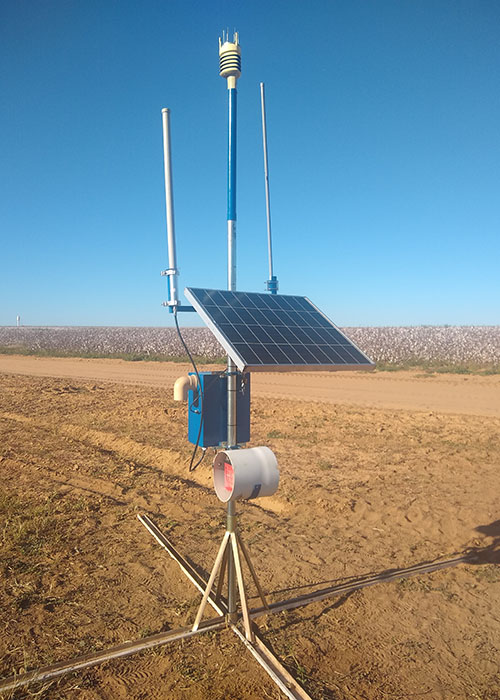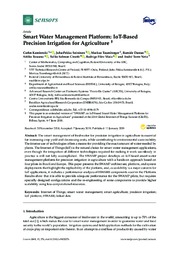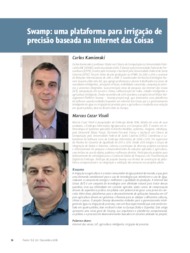Internet of Things tested in precision irrigation
Internet of Things tested in precision irrigation
Photo: Marcos Visoli

Equipment captures soil data, submits them for processing and activates irrigators with only the amount of water required.
| Highlights:
|
Brazilian and European researchers have been setting up sensors in pilot experiments and building a computational platform for the smart management of precision irrigation based on the Internet of the things (IoT). The tests located in Brazil, Spain and Italy are led by the international research consortium Smart Water Management Platform (Swamp), which was approved in the 4th Brazil-European Union Coordinated Call for Information and Communication Technologies (ICT) in 2017.
The cutting-edge technology platform comprises a wireless network that collects agronomic and soil moisture data in different areas and depths, and assesses plants' irrigation needs. The information is sent to computers installed in the agricultural properties and then on to a computational cloud, where they are stored and processed, with the aim of optimizing the process of irrigation and the use of water in agriculture.
The first experiments have already demonstrated the system's viability and reproduction potential in Brazil and abroad. In order to validate the technology and analyze its performance and scalability, there was also a simulation of the use of up to 45,000 sensors for field data collection and integration with other computational models. The tests carried out in the three countries nevertheless pointed to the need for customized models with respect to the rational use of water and integration with different technologies so that the application of IoT is more generally adopted in precision irrigation.
In Brazil, the pilots are located in the Northeastern and Southeastern regions of the country. In the European continent, they are being conducted in Northern Italy, in the region of Emilia-Romagna, and South of Spain, in Cartagena. The study involves 11 institutions, including Embrapa, the Federal University of ABC (UFABC), the Federal University of Pernambuco (UFPE), the Ignatian Educational Foundation “Padre Sabóia de Medeiros” University Center (FEI), the University of Bologna in Italy, Intercrop from Spain, and the VTT Technical Research Centre in Finland.
Brazil in the vanguard of agricultural IoT
According to UFABC professor Carlos Alberto Kamienski, leader of the research in the country, the initiative is innovative and places Brazil in the same level of leading countries in IoT technology applied to agriculture. There are several ongoing studies abroad, but there is not a platform available in the market yet. The expectation is that Swamp generates results that can be used by other companies that offer services to farmers, with significant impacts in cost and energy reductions, improving agricultural productivity with sustainability.
Automation is one of the challenges in research
In late 2019, an experiment from the project started to be implemented in the region of Matopiba, which encompasses the Brazilian states of Maranhão, Tocantins, Piauí and Bahia. In the field, the team found several obstacles that hinder the use of IoT. Besides the communication instability, the distance from the farm's office to the center pivot (equipment that performs irrigation) and the distance from the farm to the center of the nearest village are some of the main challenges, reports the Embrapa Instrumentation researcher André Torre Neto.
Software development for IoT-based, fully automated smart apps is important to advance in the sector. The expert reports that it lacks advanced IoT software platform to automate processes and integrate different technologies, like Internet of Things itself, big data analysis, and fog and cloud computing for the implementation of pilot apps in smart water management. Fog computing, in the scope of the project, refers to the data processing performed in the rural property, in equipment that aggregates the data collected in the sensors.
“The project is using cutting-edge computing technology, in the areas of communications, computational platform and cloud computing. The combined application of these technologies in issues related to irrigation is the focus of the project, but we follow a strategy so that the results can also be used in other challenges for agriculture”, states Marcos Visoli, a researcher from Embrapa Agricultural Informatics.
The open source platform can be set up in many ways, focusing on different challenges, that is, it should be flexible enough to adapt to several scenarios and crops, keeping the human effort to a minimum level. The scientists report that the four Swamp pilots supply enough diversity to help to understand the generality and specificity levels to be fed into the different software components.
“It is possible to form different systems like those recommended by Swamp, personalized to deal with the requirements and restrictions of different configurations, countries, climates, soils and crops. This requires flexibility to adapt to a range of implementation configurations involving a varied set of technologies”, Kamienski affirms.
The implementation process ranges from data collection and remote real-time broadcast through wireless communication technologies, cloud storage, to the integration with data from different experiments for different crops and regions. It is also necessary to ensure the security of the information with cryptography during the Brazilian and European teams' sharing and online access.
In parallel with the computational simulations, a simplified test version based on the same Swamp architecture was installed, but using a set of sensors in an experimentation environment at Embrapa's National Reference Laboratory on Precision Agriculture (Lanapre), located in São Carlos, SP. To conduct the study, the researchers developed multiparametric probes for soil sensing, which include moisture, temperature and electric conductivity sensors in three depths.
IoT in grains and grapes
In Matopiba, the project's challenge is to implement a Variable Rate Irrigation (VRI)-based smart irrigation system, aiming at reducing energy consumption, which represents up to 30% of the cost of producing grains like soybeans and cotton. According to Torre Neto, who participates in the project with the development of wireless sensors, VRI is able to provide the same yield with about 30% of the normal water usage (up to 50% depending on the soil type), which decreases the cost of energy.
The set of sensors developed by Embrapa and tested in São Paulo was adapted for implementation in a farm located in the Matopiba region that mostly produces cotton and soybeans. The main challenge is to bring the field data to the cloud in real time and generate models to calculate estimates, considering the soil moisture and the phenologic state of the plants. The results will contribute to perfecting the models used by the Food and Agriculture Organisation of the United Nations (FAO), which are based only on rainfall, that is, they do not consider soil conditions and crop growth stages.
Meanwhile, the pilot experiment in the Brazilian Southeast has been held at Guaspari Winery, located in the Mantiqueira mountain range, in the town of Espirito Santo do Pinhal, São Paulo, which has been using sensors installed in their vineyard. They aim to perform automatic measuring of soil water content at different soil depths and provide quick and accurate irrigation management information, according to the Embrapa Instrumentation researcher Luis Henrique Bassoi, who also integrates the team with the analyst Ednaldo José Ferreira.
Reduced water consumption in Europe
In the European continent, the experiments are being conducted with more simplified versions of communication and storage infrastructure in comparison with the ones used in the Matopiba and the winery landscapes. In the North of Italy, the main challenge of the pilot led by the Bonifica dell'Emilia Centrale Consortium (CBEC), responsible for irrigation and water draining in the Emilia-Romagna region, is to optimize water distribution.
The intention is to increase the usage of water passing along the canals, based on the real irrigation demand coming from three selected farms, which grow different crops (vineyards and pears) and use different irrigation systems. “This will allow CBEC to significantly reduce water waste and energy used in pumps by advanced management practices, and to optimize irrigation by monitoring the water balance at the farm”, Kamienski cites the paper.
In Spain, the pilot is located in Cartagena, within the premises of Intercrop Iberica. There, the project's challenge is to reduce the water used in irrigation and to maximize yield per amount of water, preventing waste and reducing operational and environmental costs. Two crops are grown in the same selected pilot plot: spinach and lettuce. The two vegetables are irrigated by portable sprinkler and drip systems, respectively.
Torre Neto recalls that even though Cartagena is located on the coast, it faces a serious water scarcity problem because it is located in a semi-arid area with a very short rain season. Part of of water comes from a desalination plant. “Unlike the other projects, at the Intercrop pilot the plotting area is entirely dedicated to the experiments with IoT and irrigation. Therefore, the level of freedom is higher and the risks can be taken with smaller negative consequences. The irrigation precision level is much higher, because we work with smaller temporary crops, which require more detailed monitoring”, he asserts.
Public presentation of results
The researchers are improving the platform's implementation scenarios by reporting the general work of the Swamp approach in the pilots, including the experience with models and irrigation and performance analyses. The project searchs to develop and improve both the SWAMP concepts like architecture, platform, pilots and the implementation of the solution for collaborative smart water management applications, including with the use of drones for data collection.
The expectation is that by mid-2020 all the pilots will have already been working and that water estimate models will be operating to indicate when and the amount to irrigate in each studied region. These indicators can represent considerable savings due to the optimization in the distribution of water resources, since in Italy alone there is a waste of about 80% of the water removed from the canals for crop irrigation.
Assessments of the proposed architecture through simulation have been reported in the paper “Smart Water Management Platform: IoT-Based Precision Irrigation for Agriculture”, authored by Brazilian and European researchers and published on the international periodical Sensors, an open-access leader in sensors and biossensor science and technology. The paper is an extended version of the one presented at the 2018 Global Internet of Things Summit in Bilbao, Spain..
Translation: Mariana Medeiros, based on abovementioned paper.
Joana Silva (MTb 19.554/SP)
Embrapa Instrumentation
Press inquiries
instrumentacao.imprensa@embrapa.br
Phone number: +55 16 2107-2901
Nadir Rodrigues (MTb 26.948/SP)
Embrapa Agricultural Informatics
Press inquiries
informatica-agropecuaria.imprensa@embrapa.br
Phone number: +55 19 3211-5747
Further information on the topic
Citizen Attention Service (SAC)
www.embrapa.br/contact-us/sac/


